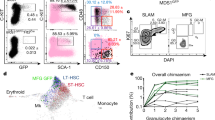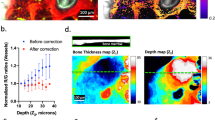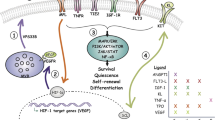Abstract
Stem cells reside in a specialized regulatory microenvironment or niche1,2, where they receive appropriate support for maintaining self-renewal and multi-lineage differentiation capacity1,2,3. The niche may also protect stem cells from environmental insults3 including cytotoxic chemotherapy and perhaps pathogenic immunity4. The testis, hair follicle and placenta are all sites of residence for stem cells and are immune-suppressive environments, called immune-privileged sites, where multiple mechanisms cooperate to prevent immune attack, even enabling prolonged survival of foreign allografts without immunosuppression4. We sought to determine if somatic stem-cell niches more broadly are immune-privileged sites by examining the haematopoietic stem/progenitor cell (HSPC) niche1,2,5,6,7 in the bone marrow, a site where immune reactivity exists8,9. We observed persistence of HSPCs from allogeneic donor mice (allo-HSPCs) in non-irradiated recipient mice for 30 days without immunosuppression with the same survival frequency compared to syngeneic HSPCs. These HSPCs were lost after the depletion of FoxP3 regulatory T (Treg) cells. High-resolution in vivo imaging over time demonstrated marked co-localization of HSPCs with Treg cells that accumulated on the endosteal surface in the calvarial and trabecular bone marrow. Treg cells seem to participate in creating a localized zone where HSPCs reside and where Treg cells are necessary for allo-HSPC persistence. In addition to processes supporting stem-cell function, the niche will provide a relative sanctuary from immune attack.
This is a preview of subscription content, access via your institution
Access options
Subscribe to this journal
Receive 51 print issues and online access
$199.00 per year
only $3.90 per issue
Buy this article
- Purchase on Springer Link
- Instant access to full article PDF
Prices may be subject to local taxes which are calculated during checkout



Similar content being viewed by others
References
Fuchs, E., Tumbar, T. & Guasch, G. Socializing with the neighbors: stem cells and their niche. Cell 116, 769–778 (2004)
Li, L. & Xie, T. Stem cell niche: structure and function. Annu. Rev. Cell Dev. Biol. 21, 605–631 (2005)
Arai, F. et al. Tie2/angiopoietin-1 signaling regulates hematopoietic stem cell quiescence in the bone marrow niche. Cell 118, 149–161 (2004)
Niederkorn, J. Y. See no evil, hear no evil, do no evil: the lessons of immune privilege. Nature Immunol. 7, 354–359 (2006)
Adams, G. B. & Scadden, D. T. The hematopoietic stem cell in its place. Nature Immunol. 7, 333–337 (2006)
Zhang, J. et al. Identification of the haematopoietic stem cell niche and control of the niche size. Nature 425, 836–841 (2003)
Calvi, L. M. et al. Osteoblastic cells regulate the haematopoietic stem cell niche. Nature 425, 841–846 (2003)
Feuerer, M. et al. Bone marrow as a priming site for T-cell responses to blood-borne antigen. Nature Med. 9, 1151–1157 (2003)
Joffre, O. et al. Prevention of acute and chronic allograft rejection with CD4+CD25+Foxp3+ regulatory T lymphocytes. Nature Med. 14, 88–92 (2008)
Zou, L. et al. Bone marrow is a reservoir for CD4+CD25+ regulatory T cells that traffic through CXCL12/CXCR4 signals. Cancer Res. 64, 8451–8455 (2004)
Mazo, I. B. et al. Hematopoietic progenitor cell rolling in bone marrow microvessels: parallel contributions by endothelial selectins and vascular cell adhesion molecule 1. J. Exp. Med. 188, 465–474 (1998)
Lo Celso, C. et al. Live-animal tracking of individual haematopoietic stem/progenitor cells in their niche. Nature 457, 92–96 (2009)
Sipkins, D. A. et al. In vivo imaging of specialized bone marrow endothelial microdomains for tumour engraftment. Nature 435, 969–973 (2005)
Huang, Y. et al. Matching at the MHC class I K locus is essential for long-term engraftment of purified hematopoietic stem cells: a role for host NK cells in regulating HSC engraftment. Blood 104, 873–880 (2004)
Jung, Y. et al. Regulation of SDF-1 (CXCL12) production by osteoblasts; a possible mechanism for stem cell homing. Bone 38, 497–508 (2006)
Sugiyama, T., Kohara, H., Noda, M. & Nagasawa, T. Maintenance of the hematopoietic stem cell pool by CXCL12-CXCR4 chemokine signaling in bone marrow stromal cell niches. Immunity 25, 977–988 (2006)
Méndez-Ferrer, S. et al. Mesenchymal and haematopoietic stem cells form a unique bone marrow niche. Nature 466, 829–834 (2010)
Welniak, L. A., Blazar, B. R. & Murphy, W. J. Immunobiology of allogeneic hematopoietic stem cell transplantation. Annu. Rev. Immunol. 25, 139–170 (2007)
Bustin, S. A. Absolute quantification of mRNA using real-time reverse transcription polymerase chain reaction assays. J. Mol. Endocrinol. 25, 169–193 (2000)
Acknowledgements
This work was supported by Bullock fellowship (to J.F.), the Harvard Stem Cell Institute and DoD W81XWH-10-1-0217 (to J.F. and C.P.L.), NIH HL097748 (to C.P.L.), HL97794 (to D.T.S.), CA111519 (to M.S.), AI041521 (to T.B.S), EMBO (to C.L.C.), HFSP (to C.L.C.), philanthropic sources (to D.T.S. and C.L.C.), and the National Institutes of Health. We acknowledge J. Zhao and D. Cao for cell sorting.
Author information
Authors and Affiliations
Contributions
J.F. conceived the overall project, designed and performed experiments, analysed data and wrote the manuscript. J.W. and A.L.C. contributed to intravital imaging. L.S. and J.F. performed histology analysis. P.P. and J.F. performed qRT–PCR analysis. R.L. and J.F. performed FACS analysis using intracellular staining. W.G. performed mouse breeding. J.F., H.T. and T.S. performed HSPC isolation. D.C. generated software for IVM. T.I.S., C.L.C., M.S., T.B.S. and D.T.S. provided advice on the design of experiments. D.T.S. edited the manuscript. C.P.L. helped design experiments, supervised the overall study and wrote the manuscript.
Corresponding authors
Ethics declarations
Competing interests
The authors declare no competing financial interests.
Supplementary information
Supplementary Information
The file contains Supplementary Figures 1-9 with legends and a Supplementary Table. (PDF 1474 kb)
Rights and permissions
About this article
Cite this article
Fujisaki, J., Wu, J., Carlson, A. et al. In vivo imaging of Treg cells providing immune privilege to the haematopoietic stem-cell niche. Nature 474, 216–219 (2011). https://doi.org/10.1038/nature10160
Received:
Accepted:
Published:
Issue Date:
DOI: https://doi.org/10.1038/nature10160
This article is cited by
-
Cellular niches for hematopoietic stem cells in bone marrow under normal and malignant conditions
Inflammation and Regeneration (2023)
-
Aged hematopoietic stem cells entrap regulatory T cells to create a prosurvival microenvironment
Cellular & Molecular Immunology (2023)
-
Modulation of bone remodeling by the gut microbiota: a new therapy for osteoporosis
Bone Research (2023)
-
The roles of bone remodeling in normal hematopoiesis and age-related hematological malignancies
Bone Research (2023)
-
Conserved transcriptional connectivity of regulatory T cells in the tumor microenvironment informs new combination cancer therapy strategies
Nature Immunology (2023)
Comments
By submitting a comment you agree to abide by our Terms and Community Guidelines. If you find something abusive or that does not comply with our terms or guidelines please flag it as inappropriate.



